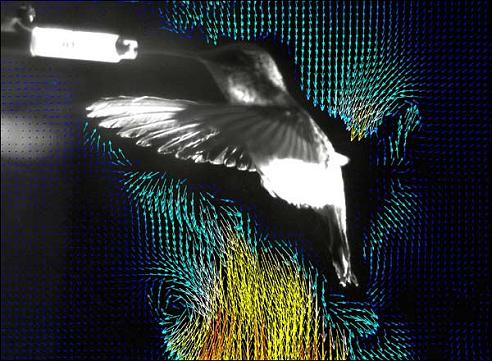The tiny hummingbird, not much bigger than a honey bee, is able to hover gently over flowers because it uses its wings much like insects. However, a new study reveals that this similarity is not as far-reaching as it used to be thought.

The tiny hummingbird, not much bigger than a honey bee, is able to hover gently over flowers because it uses its wings much like insects. However, a new study reveals that this similarity is not as far-reaching as it used to be thought.
According to the study, the hummingbird is located right in the middle between birds, who get all their lift from the downward movement of their wings, and insects, who get an equal amount of lift from the downward and upward movement of their wings.
The researchers, from the University of Portland and Oregon State University, used sophisticated technology to study the movement of air around the hummingbird's wings and provide data on its flight, which until now had only been estimates. The findings: The hummingbird gets 75% of its lift from the downward movement of its wings and the remaining 25% from the upward movement of its wings.
The head of the team of researchers, zoologist Douglas Varic, said that the study, published last week in the journal "Nature" presents a convincing example of convergence - the development of identical traits in unrelated species. According to Varik, the findings probably represent "the limit of natural selection's ability to make the bodies of birds look and function like the bodies of insects, in everything related to aviation."
Varic and biologist Bret Tobelsky placed feeding facilities for hummingbirds inside a tunnel, inside which they also placed a laser device connected to a computer, which measures the movement of tiny particles swirling in the air. The device allowed the researchers to produce "pictures" of the wing movements of the hummingbirds at intervals of 250 millionths of a second. The results challenged the hypothesis that the hummingbird receives the same lift force from the downward movement of the wings as from the upward movement, similar to insects.
According to Michael Dickinson, a bioengineering researcher at Caltech University in California who has studied hummingbirds and insects, the basis for this assumption was the fact that birds and insects move their wings in a similar way. "They look so similar, function in a similar way and their size is quite similar," added his colleague Varic. "These similarities have always led people to believe that hummingbirds fly like insects. But the hummingbird will never be anything but a bird."
Ross Hawkins, founder of the National Hummingbird Society in the United States, said the study is a good example of how science improves knowledge of the animal world. He said that it was only thanks to new research that they were able to root out a custom that had prevailed for decades - putting honey in feeding facilities for hummingbirds. In the new studies it became clear that honey causes infections in the birds' tongues and their throats.

3 תגובות
What is the speed of the wings per second?
http://www.youtube.com/watch_popup?v=hjnc1kHMDDo&feature=player_embedded
The hummingbird islands are harmful